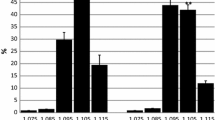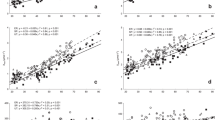Summary
The purpose of this study was to examine the effect of intense interval training on erythrocyte 2,3-diphosphoglycerate (2,3-DPG) levels at rest and after maximal exercise. Eight normal men, mean ± SE=24.2±4.3 years, trained 4 days·week−1 for a period of 8 weeks. Each training session consisted of eight maximal 30-s rides on a cycle ergometer, with 4 min active rest between rides. Prior to and after training the subjects performed a maximal 45-s ride on an isokinetic cycle ergometer at 90 rev·min−1 and a graded leg exercise test (GLET) to exhaustion on a cycle ergometer. Blood samples were obtained from an antecubital vein before, during and after the GLET only. Training elicited significant increases in the amount of work done during the 45-s ride (P<0.05), and also in maximal oxygen uptake (\(\dot V_{{\text{O}}_{\text{2}} }\) max: Pre=4.01±0.13; Post=4.29±0.07 l·min−1;P<0.05) during exercise and total recovery\(\dot V_{{\text{O}}_{\text{2}} }\) (Pre=19.14±0.09; Post=21.45±0.10 l·30 min−1;P<0.05) after the GLET. After training blood lactate was higher, base excess lower and pH lower during and following the GLET (P<0.05 for all variables). Training caused no significant differences in erythrocyte 2,3-DPG levels at rest (Pre=11.8±0.7; Post=12.1±0.7 Μmol·g−1 hemoglobin (Hb);P>0.05), at exhaustion (Pre=12.0±0.8; Post=11.2±0.8 Μmol·g−1 Hb;P>0.05) or during 30 min of recovery from the GLET. Additionally, acute exercise (pre-training GLET) did not effect any change in 2,3-DPG at exhaustion or during recovery from exercise compared to resting values. The higher\(\dot V_{{\text{O}}_{\text{2}} }\) max and total recovery\(\dot V_{{\text{O}}_{\text{2}} }\) values observed after training appear to be unrelated to 2,3-DPG levels. Under the present conditions, the role, if any, of 2,3-DPG in enhancing tissue oxygenation during increased metabolic demand remains obscure.
Similar content being viewed by others
References
ABL-2 Training Manual (1977) The London Co., Cleveland, p D9
Benesch R, Benesch RE (1969) Intracellular organic phosphates as regulators of oxygen release by haemoglobin. Nature 221: 618–622
Boning D, Schweigart U, Tibes U, Hemmer B (1975) Influences of exercise and endurance training on the oxygen dissociation curve of blood under in vivo and in vitro conditions. Eur J Appl Physiol 34: 1–10
Bonner HW, Tate CA, Buffington CK (1975) Changes in erythrocyte 2,3 diphosphoglycerate in women following short term maximal exercise. Eur J Appl Physiol 34: 227–232
Brauman KM, Boning D, Trost F (1979) Oxygen dissociation curves in trained and untrained subjects. Eur J Appl Physiol 42: 51–60
Brauman KM, Boning D, Trost F (1982) Bohr effect and slope of the oxygen curve after physical training. J Appl Physiol 52: 1524–1529
Chanutin A, Curnish RR (1967) Effect of organic and inorganic phosphate on the oxygen equilibrium of human erythrocytes. Arch Biochem Biophys 121: 96–102
Faulkner JA, Brewer GJ, Eaton JW (1970) Adaptation of the red blood cell to muscular exercise. In: Brewer GJ (ed) Red cell metabolism and function. Plenum Press, New York, pp 213–217
Galbo H (1983) Hormonal and metabolic adaptation to exercise. Thieme Stratton Inc, Stuttgart, p 87
Hartley LH, Mason JW, Hogan RP, Jones LG, Kotchen TA, Mougy EH, Wherry FE, Pennington LL, Ricketts PT (1972) Multiple hormonal responses to graded exercise in relation to physical training. J Appl Physiol 33: 602–606
Jones NL, Sutton JR, Taylor R, Toews CJ (1977) Effect of pH on cardiorespiratory and metabolic responses to exercise. J Appl Physiol 43: 959–964
Katz A, Sharp RL, Armstrong LE, King DS (1984) Oxygen tension in antecubital blood of trained and untrained males after maximal leg exercise. Can J Appl Sports Sci [in press]
Kindermann W, Keul J, Huber G (1977) Physical exercise after induced alkalosis (bicarbonate or Tris-buffer). Eur J Appl Physiol 37: 197–204
Lenfant C, Torrance JD, Reynafarje C (1971) Shift of the O2-Hb dissociation curve at altitude: mechanism and effect. J Appl Physiol 30: 625–631
Meen HD, Holter PH, Refsum HE (1981) Changes in 2,3-diphosphoglycerate (2,3-DPG) after exercise. Eur J Appl Physiol 46: 177–184
Osnes JB, Hermansen L (1972) Acid-base balance after maximal exercise of short duration. J Appl Physiol 32: 59–63
Ramsey JM, Pipoly SW Jr (1979) Response of erythrocytic 2,3-diphosphoglycerate to strenuous exercise. Eur J Appl Physiol 40: 227–233
Rand PW, Norton JM, Barker N, Lovell M (1973) Influence of athletic training on hemoglobin-oxygen affinity. J Appl Physiol 224: 1334–1337
Rapoport S, Guest GM (1939) The decomposition of diphosphoglycerate in acidified blood: its relationship to reactions of the glycolytic cycle. J Biol Chem 129: 781–790
Remes K, Harkonen M, Vuopio P, Peltokallio P (1975) The decrease in 2,3-diphosphoglycerate concentration in long distance running. J Sports Med 15: 113–116
Sahlin K, Alvestrand A, Brandt R, Hultman E (1978) Intracellular pH and bicarbonate concentration in human muscle during recovery from exercise. J Appl Physiol 45: 474–480
Shappell SD, Murray JA, Bellingham AJ, Woodson RD, Detter JC, Lenfant C (1971) Adaptation to exercise: Role of hemoglobin affinity for oxygen and 2,3-diphosphoglycerate. J Appl Physiol 30: 827–832
Sharp RL, Costill DL, Fink WJ, King DS (1983) The effects of eight weeks of sprint training on the buffer capacity of muscle in man. Med Sci Sports Exerc (abstract) 15: 116
Smalley KA, Runyan WS, Puhl JL (1981) Effect of training on erythrocyte 2,3-diphosphoglycerate in two groups of women cross-country runners. J Sports Med 21: 352–358
Taunton JE, Taunton CA, Banister EW (1974) Alterations in 2,3-dpg and p50 with maximal and submaximal exercise. Med Sci Sports 6: 238–241
Thomas HM, Lefrak SS, Irwin RS, Fritts HW Jr, Caldwell PRB (1974) The oxyhemoglobin dissociation curve in health and disease. Am J Med 57: 331–348
Thomson JM, Dempsey JA, Chosy LW, Shahidi NT, Reddan WG (1974) Oxygen transport and oxyhemoglobin dissociation during prolonged muscular work. J Appl Physiol 37: 658–664
Author information
Authors and Affiliations
Additional information
Supported by grants from Miles Laboratories, Elkhart, Indiana, and the Ball State Graduate Student Research Fund
Rights and permissions
About this article
Cite this article
Katz, A., Sharp, R.L., King, D.S. et al. Effect of high intensity interval training on 2,3-diphosphoglycerate at rest and after maximal exercise. Europ. J. Appl. Physiol. 52, 331–335 (1984). https://doi.org/10.1007/BF01015222
Accepted:
Issue Date:
DOI: https://doi.org/10.1007/BF01015222




